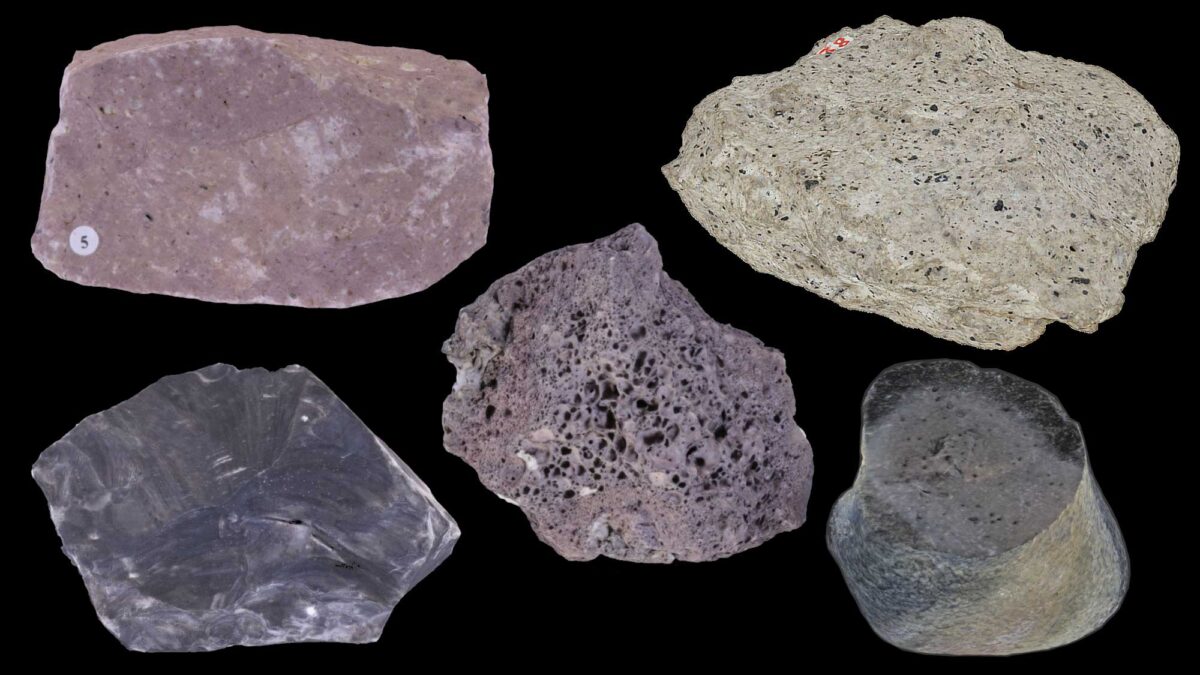Virtual Rock Collection
Igneous Rocks
Sedimentary Rocks
Metamorphic Rocks
Image above: Examples of different types of extrusive igneous rocks. Sources of individual rock images are derived from 3D models on Sketchfab with Creative Commons licensing; see same models below for creator credits and licensing details.
Overview
Extrusive (or, volcanic) igneous rocks are formed on the Earth’s surface as the result of volcanic activity. They tend to have small crystal sizes because they cool very quickly. These small crystals are referred to as aphanitic because they often cannot be seen with the naked eye. That said, larger, visible crystals called phenocrysts may be present within the surrounding groundmass (or, matrix) of aphanitic crystals. Extrusive igenous rocks with phenocrysts in an aphanitic matrix are called porphyry; they form when magma has partially cooled below the surface (forming the phenocrysts) and is then erupted and rapidly cooled (forming the aphenitic matrix).
The colors of extrusive igneous rocks depend upon the minerals present. Felsic extrusive igneous rocks (e.g., rhyolite) are usually light in color (though obsidian is a notable exception; see below) because they are rich in minerals like feldspar that contain a lot of Al, Na, or K. Mafic extrusive igneous rocks (e.g., basalt) are darker in color, again reflecting the compositions of the minerals present, which tend to be rich in Mg and Fe. There are, of course, extrusive igenous rocks with compositions that are somewhere between felsic and mafic (e.g., dacite and andesite).
Crystalline Extrusive Igneous Rocks
These igneous rocks have textures composed of interlocking crystals, usually of varying mineral composition. Rhyolite, dacite, andesite, and basalt are crystalline extrusive igneous rocks form a continuum of composition from felsic to mafic and are presented in this order below.
Rhyolite
Rhyolite is the extrusive equivalent of granite. It is felsic in composition and contains large amounts of potassium feldspar and quartz, commonly giving it a pink color.
Sample of rhyolite from Castle Rock, Colorado. Longest dimension of sample is approximately 11 cm. Specimen is from the teaching collections of the Paleontological Research Institution, Ithaca, NY (Sketchfab; Creative Commons Attribution-ShareAlike 4.0 International license).
Dacite
Dacite is the extrusive equivalent of granodiorite. Quartz and plagioclase feldspar are abundant minerals, often giving dacite a grayish color.
Andesite
Andesite is the extrusive equivalent of diorite. Plagioclase feldspar is abundant, but quartz is nearly absent; mafic minerals are present, giving this type of rock a dark color.
Basalt
Basalt is the extrusive equivalent of gabbro. It is dark in color and dominated by mafic minerals such as pyroxene. Most magmas that erupt from volcanos form basalt.
Sample of basalt from Hawaii with a smooth "pahoehoe" form. Longest dimension of specimen is approximately 8 cm (Sketchfab; Creative Commons Attribution-ShareAlike 4.0 International license).
Fragmental Extrusive Igneous Rocks
Fragmental extrusive igenous rocks are formed from fragments that are exploded out of the Earth, settle, and then become welded together as they quickly cool. Tuff is an example.
Tuff
A tuff is an extrusive igneous rock that has formed from lithified volcanic ash. Tuffs often appear as layered rocks at the outcrop scale.
Original caption: "This outcrop is the lower section of the cliff at Swansea Heads near Newcastle, Australia. Most of the section shown is the thick (~10 metres) tuff unit of the Reids Mistake Member of the Newcastle Coal Measures - a coal seam can be seen toward the top of the section. Coal also underlies the tuff, and the preserved remains of dozens of Glossopteris trees are present in the lower parts of the tuff on the rock platform." Model by Earth Sciences, University of Newcastle (Sketchfab).
Glassy Extrusive Igneous Rocks
Glassy extrusive igenous rocks contain a large amount of silica (Si) and form when lava cools very quickly, preventing the formation of individual mineral grains. Examples include obsidian, pumice, and scoria.
Obsidian
Obsidian is volcanic glass composed almost entirely of silica, making it felsic, despite its color. Scallop-shaped conchoidal fractures are common on obsidian samples.
Pumice
Pumice is a glassy extrusive igneous rock that has many small holes called vesicles, the result of air bubbles that were present in erupted lava before it cooled. Some samples are so porous that they float when placed in water.
Scoria
Scoria is similar to pumice, but has larger vesicles (holes). It is often reddish in color.
Sample of scoria from Rocoş, Romania. Model by the Museum of Mineralogy and Petrography, UAIC (Sketchfab).



